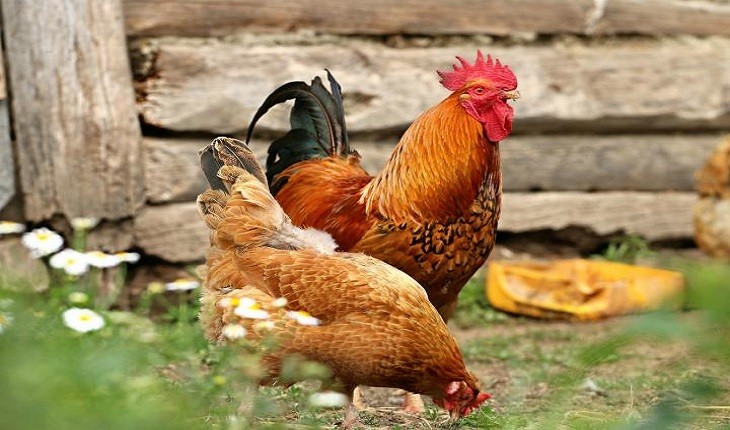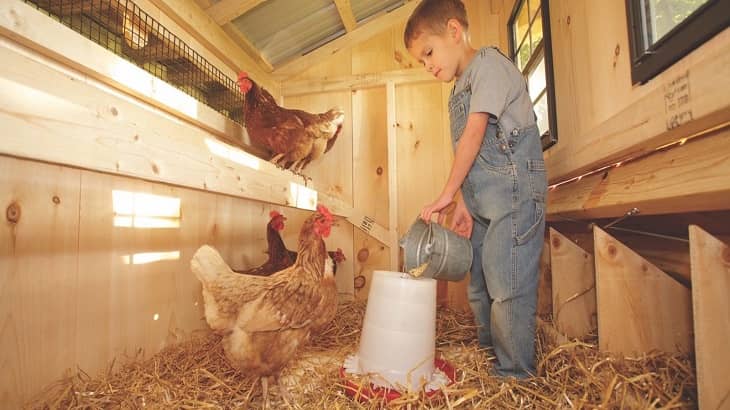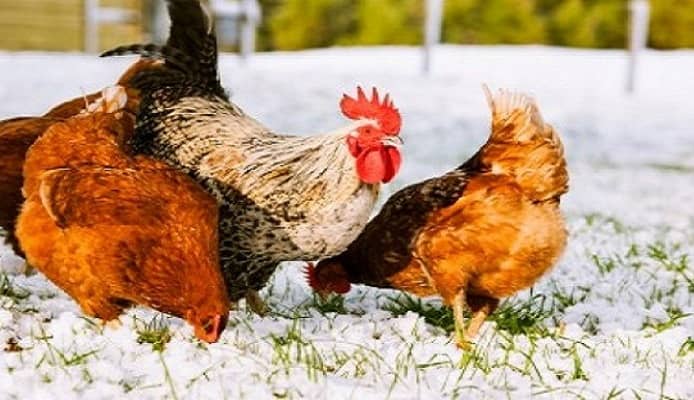Got a nice little backyard with a good breeze and sunshine? And maybe some spare planks of wood too? Then, my friend, you are already one step ahead in your poultry farming journey.
At first, it might sound like pushing water uphill with a rake; especially when you’ve grown up in a big city.
You might have questions like- How am I going to take care of them or what do I feed them? But most importantly, how to raise chickens in winter?
Relax, you don’t have to bring the flock inside your living room and round them up around the fireplace while it snows outside.
With a little modification to the chicken coop and feed, it’s safe to say that your flock will survive the wintertime in perfect health!

What Is a Good Temperature for Raising Chickens?
Having a flock of hens and cockerels is exciting; especially when you’re getting fresh eggs every day. But when the temperature begins to drop, you have to pay more attention to your flock. A rule of thumb is to maintain a comfortable temperature and humidity.
Before we get to that, you should keep in mind that hatching chickens in incubators are a whole another topic. As for today, we’ll only share the most effective tips and tricks of raising backyard chickens in cold weather.
To begin with, a temperature between 65°F and 75°F is ideal for rearing chickens. Anything below 65°F is still pretty tolerable for adult chickens, but it causes extra stress to their bodies. Especially when they’re not of a cold hardy breed like Rhode Island Reds.
Why put your favorite birds through the ordeal when you can keep the chickens warm without electricity, right? Head on to the following part where we discuss DIY chicken coop insulation at length!
Insulating the Chicken Coop Without A Heat Lamp

As you already know, chickens have fluffy feathers to regulate their body temperature. Warm weather chickens especially have a hard time coping with steep temperature falls. Got Orping tons and Andalusians? You’re in for double trouble.
Similarly, if you’re raising White Leghorns or Brahmas, seeing them all huddled together during heavy snow will be a common sight. And it might prompt you to get an inexpensive heat lamp or a chicken sweater.
But the truth is, chickens naturally prefer staying a bit cold and fresh. That is why they are constantly panting and flapping their wings in midsummer. On the other hand, it is their natural instinct to huddle together in wintertime and stay nestled in their comfortable straw bedding.
What you can do is go for some cheap insulation materials and put them under the coop and around the inner walls. We suggest saving the lamp for the coldest few weeks of the year.
A Balanced Humidity: No More Nasty Bacteria and Mold!
Since we’re already talking about the winter season, we deemed it necessary to cover the thaw drill. The fun thing about winter is that the air can get both dry and humid within a short span of time. Dry environments can create a dusty situation inside the coop leading to health issues.
On the other hand, overly humid weather can spring out mold and bacteria. And if you’re going for the deep littering method at the same time, the excess humidity can make your chickens all jittery. Make sure to wear healthy clothing and proper coop boots for maintaining the environment.
What you can do is paint the walls of the chicken coop with low VOC, non-toxic latex paint. It will keep the wooden walls from absorbing excess moisture, and therefore, stop mold and mildew growth naturally!
How to Know If Your Backyard Chickens Are Too Cold?
If you’re trying backyard poultry farming for the first time, it can be difficult to understand your flock. What might seem like a happy dance to you, could actually be signs that your chickens are, in fact, stressed out.
Worry not; we are here to break down the most common signs of knowing when your chickens are too cold.
For starters, your chickens will frequently fluff their feathers up, and sit together in the sun or the warmest part of the coop. As a matter of fact, chickens are not that active in winter. So, there’s absolutely nothing to worry about if they are not as playful and high-spirited as before.
You might also find them standing on one foot while keeping the other one closely tucked in their feathers. This wintertime disposition of chickens is a way to preserve body heat as much as possible.
That said, if your flock is posing as flamingos all day round, maybe it’s time you revamped the coop for winter.
Get Your Chicken Coop Ready for Winter!

A slightly bigger and roomier version of a birdhouse, a chicken coop is where your precious flock is going to rest. Even free-range chickens, at the end of the day, return to their coop and call it a night.
If you’ve got your chicken coop a while ago, chances are, it’s still an airy, rectangular box made of wood pellets with a shabby straw bedding thrown somewhere in between. But with winter right around the corner, winterizing the chicken coop is now important.
Without further ado, let’s walk you through all the steps of building a chicken coop from scratch!
Cardboard Blocks Chilly Crosswinds
Raising free-range chicken is hardly possible in an urban city. You need to make the best use of the few meters of land you have at the back of your house. But the best part? Making a chicken coop and insulating it for winter costs way less than maintaining an aquarium. Cool, right?
Even if there are a few drafts inside the chicken coop, covering them up with scrap cardboard does the trick. What’s more, they can completely block out the wintertime crosswinds from the sides of the coop!
Put up Thick Fabric on the Walls
While cardboard is a solid material, it could tamper with ventilation. There’s an easy solution for that. You’re going to need a few pieces of old towels or thick fabric to replace cardboards. This way you can set up quality insulation on the chicken coop windows and still have great ventilation!
If you’re not in for the rustic look, setting up curtains is a pricier approach to deal with the biting cold. It sure costs a few more bucks, but the beautiful, tidy chicken coop is worth the money!
Nothing Beats a Good Old Straw Bedding
Spreading straw on a chicken coop is an age-old tradition, one that goes perfectly well with all weathers. But wintertime calls for an extra layer of protection. And adding an additional straw bedding and bale is the way to go!
Styrofoam Makes Great Ceiling Joists!
Frankly, Styrofoam sounds a bit too sophisticated to go with a chicken coop. But it’s an effective way to insulate the coop’s roof. After all, you can’t really hang straw beddings from the top.
Styrofoam sheets are pretty inexpensive. On a lucky day, any furniture retailer can even give it to you for free!
As for the next step, you have to place Styrofoam sheets in between the ceiling studs. It doesn’t require fasteners because the studs will hold the sheets up. Styrofoam keeps your chicken coop well-insulated while blocking moisture, snowfall, and wind from above.
Top 5 Chicken Coop Essentials
If you want your chicken coop to stay fabulous all year round, stacking straw beds one after the other is not going to work. First, you need to ensure that your coop is located in the sunniest part of your backyard. You should also invest in quality wood for that urban cottage-style look.
But one thing’s for sure- having all five of these chicken coop essentials will give your flock the home they deserve! We’re talking about nesting boxes, a feeder, a heated chicken waterer, a roosting bar, and a sunroom!
It doesn’t matter what size chicken coop you have, or how many chicks there are in your flock. No coop should miss out on these vital things.
And if you have more space, consider adding an enclosed run right next to the coop. It will give all your hens and cockerels plenty of room for stretching their legs. And during winter, the run can double up as a sunroom!
How to Build a Sunroom for Chickens

For this part, you can pay a visit to the lumberyard and get stock panels and two posts. If you can manage a dome-shaped wire mesh, that’s even better! All you need to do is place 2-mil plastic sheets all over the mesh enclosure. Use proper electric chicken coop door for better entrance.
Once it’s done, the see-through plastic sheet will trap the heat from sunlight within the structure. Your chickens will have a roomy area to bask in the sun without dipping their feet in the snow!
However, you should make sure that the chicken sunroom is not one hundred percent airtight. Some amount of ventilation can stabilize humidity and make sure that the flock doesn’t feel suffocated.
All things considered, the winter hoop-house too should have ventilation. Chances are the chicks will peck and prod holes in the plastic covering anyway!
But you can use the plastic sheet as a flap that opens and locks with bungee cords. And of course, make way for a small door so that you can access the sunroom!
What to Feed Chickens during Winter
Since winter is closing in on your area, you should find new variations of chicken feed to keep your flock strong and healthy. It’s time to cook up some nutritious chicken treats that will keep the flock wanting more!
We’re looking at a blend of whole grains and cracked corn- a nourishing and yummy winter treat for your chickens. This salubrious mix is called ‘scratch’ and making it at home is super easy!
As the recipe goes, you are going to need oats, millets, currants or raisins, and of course, corn. Throwing in a few pumpkin seeds or sunflower seeds can make home-made scratch more appetizing for chickens.
On a more serious note, winter is also the time when your flock sheds more feathers. They will need extra protein to make up for the tiresome molting.
Luckily, scrambled eggs, mealworms, canned fish, spinach, and kale will help keep their body heated and grow new feathers. A boost of protein in a daily diet never goes wrong for backyard chickens!
Plain yogurt or cultured yogurt can improve your flock’s gut health, and give their immune system a healthy boost. Hanging a squash from the coop’s ceiling will give the chicks a nice thing to play with. And finally, a scrumptious mix of mealworms, pumpkin seeds, and butternut work like great boredom busters!
5 Beginner Tips for Keeping Backyard Chickens in Winter!
Keeping backyard chickens has its ups and downs. Even more so in the wintertime. There’s simply too much to do- insulate the coop, build a sunroom, change the feed, block the drafts, keep the girls active, and whatnot.
In fact, you might also find yourself rubbing a blob of petroleum jelly on the cockerels’ combs to save them from frostbites!
But it pays off when you see your flock running happily in the chicken run in tip-top shape. For now, we have rounded up the top five things you need to get done immediately!
- Add a thick layer of straws for wintertime bedding
- Get a wall heater and light for those extra frosty days
- A sunroom & a roost can beat the winter blues!
- Petroleum jelly keeps frostbites away
- Finally, use deep-littering for better insulation!
If you’re up for the deep litter method, remember to turn the litter in as often as possible. Make sure to put dry litter on top for absorbing any excess moisture. Pine pellet bedding works like magic!
Among all things, you simply can’t suck at raising chickens once you follow all the steps we mentioned above! Don’t hesitate to add a few Christmas treats to their diet, though. Your flock needs all the nutrition they can get!
Bottom Line
Given the exorbitant price of farm-fresh eggs and broilers, rearing chickens all by yourself or as a family is a great idea! But oftentimes you might have to go out of your way to keep the flock healthy, happy, and energetic.
Especially in winter when the stupor hits us all differently, serving up a proper meal for the hens can brighten up your day!
From renovating chicken coops for winter to sharing winter-friendly chicken feed recipes, we tried to cover all bases on how to raise chickens in winter. Now, all there’s left to do is to try them out for your flock. Best of luck!
